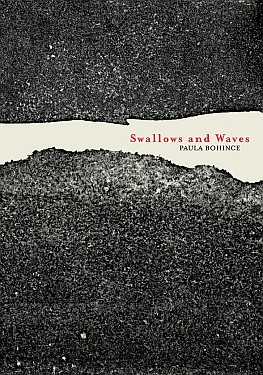PAULA BOHINCE
BOOKS
REVIEWS
PRAISE
EXCERPT
Crows
In perpetual silhouette
perform against bronze. As exhausted
dancers, undressed behind
a scrim, the suggestion of nakedness
more erotic than…
En masse, they argue and flee
between slim sessions of peace. This
is existence: pain leashed
or unleashed.
Wings press against ribs in politesse
or unfurl in demonstrations
of power. When it's over,
crows remain as debris, Ebony confetti,
wrecking more the wrecked world.
—After Crows by Unknown, Japan
(first appeared in The Nation)
Swallows and Waves
Massive, the sea sweeps
and swerves, furious as a dragon.
Salt-hewn, foam—
roughed, it troubles the thirteen
swallows who cluster—
identical, overlapping—trying
to build one steady thing.
Mist wets their breasts
and makes flying heavy. The sea
has no shore. All middle,
dense as middle age.
Birds may be welcome, then,
as minor miracles, granting grace
to that universal struggle.
—After the painting "Swallows and Waves" by Okamoto Shuki, 1785-1832, Japan
(first appeared in Tricycle)
This collection of evocative poems brings to life a world long gone but resonant with our own. Each finely wrought poem reveals hidden depths upon rereading. One not to miss.
—Library Journal, starred review
Bohince's quiet revelations shed a strange, sometimes painful light on what seems familiar... Bohince offers a discreet, surprising kind of ekphrasis.
—Publishers Weekly
A collection of surprising, almost concrete, coherence. The poems are invariably short; some vignettes are quickly sketched as if in watercolor, others more finely engraved; some poems hide a narrative, others an emotion. But most striking is that while the array of images is vast, they are tied together by a similar, stylistic sensibility.
—Asian Review of Books
Lithe and exacting, this collection draws inspiration from old Japanese woodblock prints and scroll paintings, resulting in lines at once visual and isolating.
—Foreword Reviews
Paula Bohince has written a series of exquisite ekphrastic miniatures based upon Japanese scroll paintings and woodblocks of the Edo period... Compressed and delicately shaded, the words of these poems are treated as pigments, applied sometimes in daubs of pure verbal color, sometimes in fine washes that simulate transparency.
—Jamie James, Parnassus
Ekphrasis seems too sharp a word.to describe the silky music of these elegantly balanced poems... Many Western poets, from Ezra Pound to Gary Synder, have been hopelessly in love with Japanese culture and its exotic erotics, but Bohince joins the very best of writers who slide open the screens, fully aware there are other screens still concealing our deepest pleasures and pains.
—Henry Hughes, Harvard Review
[Bohince] has a knack for startling lyricism and unusual images... Bohince's notebook of green observations and red feelings has yielded a collection of deeply sensuous poems—poems that ask us to look at the world anew.
—Lorna Knowles Blake, The Hudson Review
Ekphrasis becomes a meditation on the act of looking, on the painter's gesture and the poet's. Horace's famous ut pictura poesis (as is painting, so is poetry) becomes: as is the activity of the painter, so is the activity of the poet. Looking itself is reinterpreted as an act of reading, which thereby changes what is beheld. In these emotionally restrained lyrics, Bohince adeptly observes her own feelings as she sees them reflected in the Japanese scrolls she describes. These poems bear rereading in order to allow their delicate subtleties, like reflections on a still pond, to emerge.
—Sharon Dolin, The Hopkins Review
Each scroll and print is a scene, and from each Bohince designs a narrative, her lines heavy with precise detail, distinct motions, bare truths, and subtle wishes. Remote yet highly intimate, Swallows and Waves walks a neat path between secret and revelation.
—Laurie Saurborn, The Cincinnati Review
PRAISE
Paula Bohince's renderings of brilliantly particular Japanese woodcuts and paintings in Swallows and Waves both honor and extend their precipitating subjects. Mind-play, word-play, and world-play combine in these consummate ekphrastic poems, offering - just as the original artworks do, but in a vocabulary unmistakably Bohince's own — glimpses of life as it always exists: inside action, moment, and the implausible, multiply-layered silks, pelts, and feathers of felt existence.
—Jane Hirshfield
Paula Bohince's empathic lyrics based on Japanese scroll paintings and wood prints demonstrate "how attention and technique coalesce / into art." She has written a carefully made, elegantly poised, and deeply humane book of poems.
—Edward Hirsch
EXCERPT
Crows
In perpetual silhouette
perform against bronze. As exhausted
dancers, undressed behind
a scrim, the suggestion of nakedness
more erotic than…
En masse, they argue and flee
between slim sessions of peace. This
is existence: pain leashed
or unleashed.
Wings press against ribs in politesse
or unfurl in demonstrations
of power. When it's over,
crows remain as debris, Ebony confetti,
wrecking more the wrecked world.
—After Crows by Unknown, Japan
(first appeared in The Nation)
Swallows and Waves
Massive, the sea sweeps
and swerves, furious as a dragon.
Salt-hewn, foam—
roughed, it troubles the thirteen
swallows who cluster—
identical, overlapping—trying
to build one steady thing.
Mist wets their breasts
and makes flying heavy. The sea
has no shore. All middle,
dense as middle age.
Birds may be welcome, then,
as minor miracles, granting grace
to that universal struggle.
—After the painting "Swallows and Waves" by Okamoto Shuki, 1785-1832, Japan
(first appeared in Tricycle)


